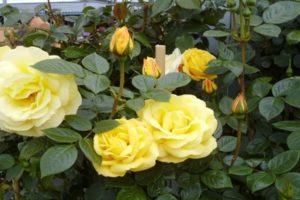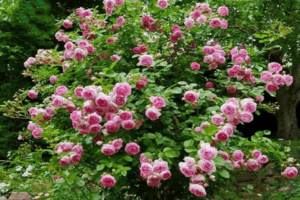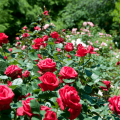The best varieties of green roses, rules of growing and care, a combination
Experts are tirelessly working on breeding more and more new varieties of roses. As a result of selection work, bushes of culture with different length of shoots and various color of buds appeared on the market. Green roses have been known since the late 18th century. Since then, gardeners have been happy to plant an exotic beauty on their plots. Below is a description of the most popular varieties of crops, information on the specifics of growing and care.
History and description
Green roses are bred by the Dutch botanist Mayer. The specialist conducted numerous experiments. In 1782 he planted a white rose on a thorn shoot. The result was the emergence of a culture with green petals.
The height of the bushes depends on the variety. The shoots are powerful, they have thorns. Inflorescences are small, large, medium. The color of the petals ranges from pale light green to dark green. They can be simple or terry. The buds are formed single or in the clusters of inflorescences.
Advantages and disadvantages
The positive qualities of a green rose include the following characteristics:
- spectacular appearance;
- variety of varieties;
- unpretentious care;
- long flowering;
- good immunity.
The lack of aroma is considered a significant disadvantage.
Popular varieties of green roses
Breeders have bred many roses with green petals. The most popular varieties are:

Green ice
The bushes of the culture reach a height of 40-50 centimeters. Gardeners use low-growing plants as a border. The buds are initially pink-green in color. The petals are shaggy, winding. At the stage of complete dissolution, the buds acquire a white-green color. In comfortable conditions, the rose blooms three times per season.
Greensleeves
The height of the bushes of this variety varies between 75-85 centimeters. The leaves are dark green, glossy. The buds are light pink at the stage of formation. Gradually, the petals acquire an emerald color. The advantage of this variety is its good black spot resistance.

Green tea
The height of the shrub is about 90 centimeters. The shape of the unblown buds is a glass. Each of them contains 25-30 petals with wavy edges. At the stage of dissolution, the bud takes the form of a deep bowl. The petals are light green.
Super green
The rose of this variety is low. Its beauty lies in the double buds. Each flower consists of 50-130 petals. The edges of the buds are colored in a light green palette.
The middle of the flower takes on a rich color.Florists love to use Super Green for their bouquets.
Limbo
The bushes of the variety are compact: the height does not exceed 80 centimeters. The leaves are large, glossy. The resulting buds have a conical shape. In full dissolution, the flower takes the form of a bowl. The petals are painted with a yellow-green palette.
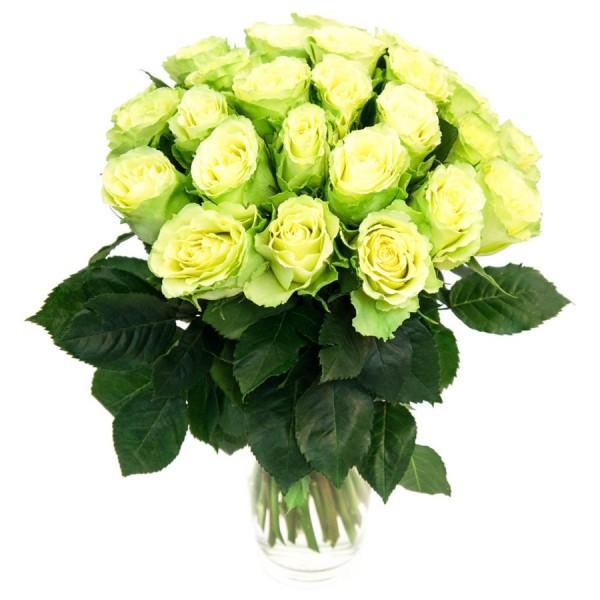
Wimbeldon
On the bushes about 1 meter high, there are rare thorns. The petals are yellow-green, wavy. The peculiarity of the variety is that a red stripe runs along the edges of the buds. The flower is loved by florists: they make beautiful compositions from the plant.
Lime sublime
The rose variety was bred by Irish specialists. The bushes bloom profusely and for a long time. The first buds form in late spring. Flowering with a short break lasts until early autumn. The petals are painted with a pale green palette. Lime tolerates the scorching sun well.
St. Patrick's day
This rose variety is intended for cultivation in the southern regions, as it does not tolerate cold well. The bud of the hybrid has a goblet shape. At the stage of dissolution, the inflorescence becomes cupped, reaching 12 centimeters in diameter. The petals are painted with a golden-green palette.

Gloria dei
The main color of the buds of Gloria Day is pink-yellow. On the petals of the variety, there are only small blotches of green color. The diameter of the inflorescences is 13-15 centimeters. The bud contains 45-50 petals. Gloria Day is the progenitor of many rose hybrids.
The specifics of growing and care
The decorativeness of green roses depends on planting in the right place and on the agrotechnical measures taken on time. Seedlings are purchased from plant nurseries or garden centers. The bushes should not have dents, spots, damaged parts. 1-2 hours before planting, the plants are placed in water, into which potassium permanganate can be added for disinfection.
Landing
Roses are planted in the ground in spring or autumn. The place is chosen sunny, protected from cold winds. The culture does not tolerate lowlands and wet areas. The substrate for plants is made up of garden soil, compost, peat, sand. A hole is dug 2 weeks before planting the bushes in open ground.
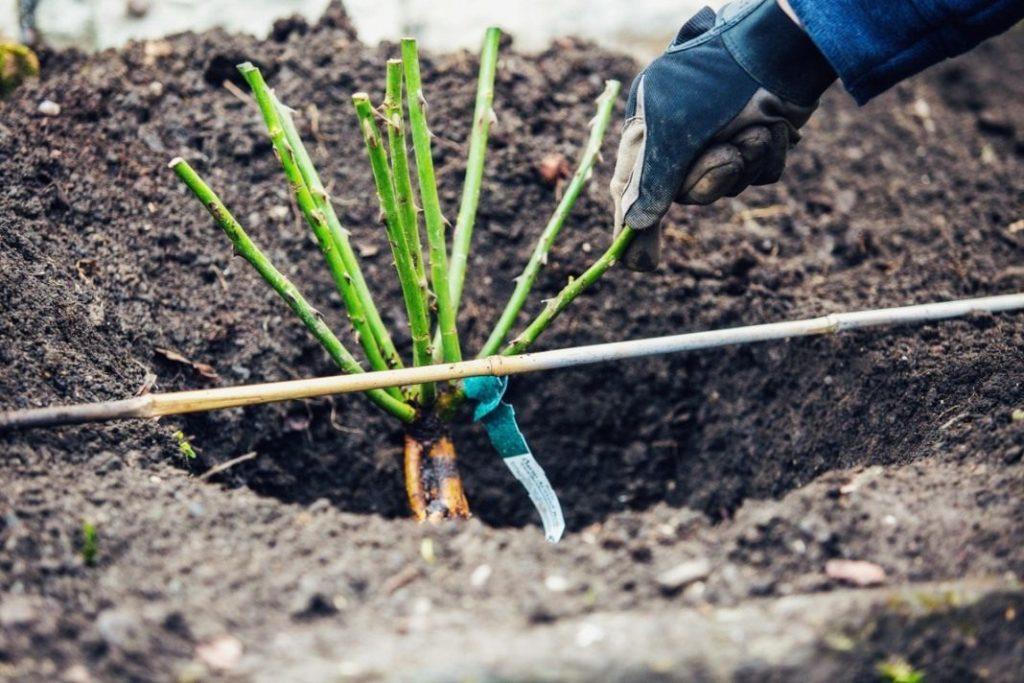
Planting a green rose as follows:
- dig a hole 50 centimeters deep and wide;
- 10-15 centimeters are filled with drainage from fine gravel, expanded clay;
- a fertile layer is poured mixed with a small amount of mineral fertilizers;
- pour the rest of the substrate in a slide;
- a bush is installed in the middle, the roots are spread;
- fall asleep with a substrate.
The bush is watered abundantly, mulched.
Specificity of care
Caring for roses consists in watering, feeding, loosening the soil, mulching. Faded buds are cut off. This is necessary for the formation of new inflorescences, as well as to maintain the decorative appearance of the bushes. To prevent the appearance of diseases, plants are sprayed with fungicides in the spring.
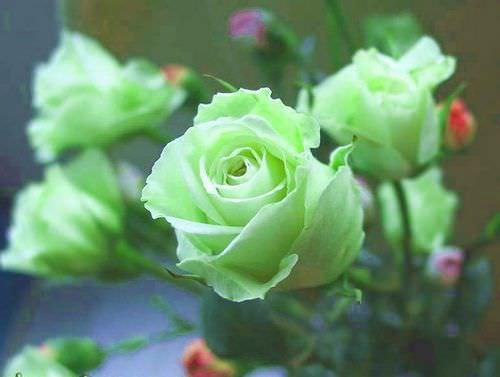
Watering
The near-trunk circle is irrigated after the top layer of the earth has dried. An excess of moisture can lead to the appearance of putrefactive microorganisms. Water the rose in the morning or evening with warm, settled water. At least 1 bucket of water is poured under the bush.
Loosening and mulching
A few days after watering, the ground around the bushes is loosened. The procedure promotes air access to the root system. When weeding, weeds are removed, which are carriers of diseases and pests. To preserve moisture, the tree trunk circle is sprinkled with mulch, consisting of sawdust, straw, peat.
Top dressing
For rapid growth of shoots, abundant and long flowering, green roses are fed several times per season. In spring, nitrogen is used, in summer - mineral fertilizers with an advantage in the composition of potassium and phosphorus. In the fall, potassium is introduced, which contributes to the successful wintering of bushes.

Pruning
Dry, broken, diseased stems are cut throughout the season. Shoots growing inward are removed.Beginning to dry buds with parts of the branches are cut off. After that, the bushes not only look more decorative, but also begin to grow young shoots from the lateral buds.
Diseases and pests
The appearance of diseases and pests on roses is facilitated by: unfavorable weather conditions, thickened plantings, damage, poor care. The presence of weeds increases the risk of pathogenic microorganisms and harmful insects attacking plants. Powdery mildew can affect green roses. Disease is promoted by a humid environment. It is manifested by the presence of powdery plaque on the leaves and shoots. Another common crop disease is rust. Due to the fungus, yellow-orange tubercles form on the leaves.
The main pest of roses is aphids. She densely clings to the shoot with the rudiment of the bud, drinks the cell juice. Another pest - spider mite - is located on the underside of the leaves. Under adverse effects, they turn yellow and fall off.
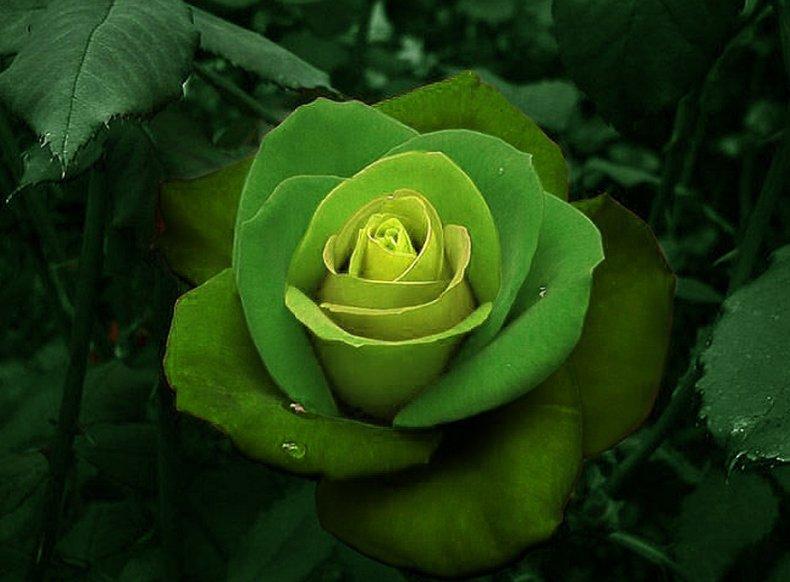
Note! To prevent the appearance of diseases and pests, the bushes are treated with special preparations several times per season.
Combination with other plants
To maximize the dignity of green roses, they need to create the right frame. Next to the bushes, whose buds are painted in dark green, bright plants are planted: tulips, verbena, snapdragon, monarda. The beauty of light green inflorescences is emphasized by lavender, sage, plants with bright pink buds. Gardeners do not recommend planting green roses next to gladioli and dahlias. Cultures are oppressive to each other.
Landscape design
Green roses are planted singly, as a curb when decorating a garden path, build a hedge out of them. They are beautifully combined with roses, which have a bright color of petals. The bushes are planted in composition with many ornamental plants. Green roses in decorative containers will look spectacular.
